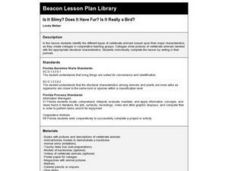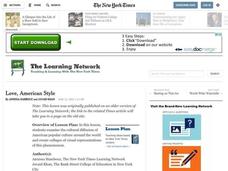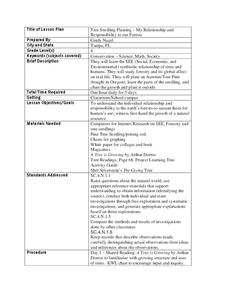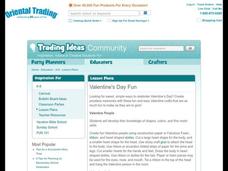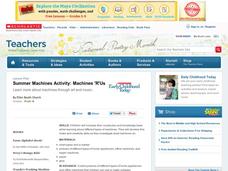Curated OER
A Sign of Their Times
Students identify the social climate that created the terms Degenerative Art and Fascist Aesthetic. They also identify how and why certain artists' artwork fell into these categories. Students recognize and discuss the Expressionist...
Sargent Art
Resist Collage/Painting on Gesso Board
Young artists mix it up by crafting a resist collage painting on a gesso board, and in the process, learn how different media embellish and affect the surface of their work. After analyzing images of the works of Mary Todd Bean and...
University of Minnesota
Beautiful Brain: Brain Inspiration
"Neuroscientists consider Cajal as important to their discipline as Einstein is to physics." The first of four lessons has scholars view Santiago Ramon y Cajal's drawings of neurons. They reflect and respond to the art through writing...
Curated OER
Miniature Landscapes
Learners demonstrate their knowledge of the elements of design by creating a pair of textured collages. They visually communicate the feeling of landscapes at different times of day by carefully selecting paper because of color or texture.
Curated OER
Is It Slimy? Does It Have Fur? Is It Really a Bird?
Sixth graders identify the different types of vertebrate animals based upon their major characteristics, as they create collages in groups. Collages show pictures of vertebrate animals labeled with the appropriate structural...
Curated OER
Environment: Sounds of the Natural World
Second graders describe and imitate sounds from the natural environment including rain and snow. After listing materials that could be used to make rainsticks, they create their own instruments from cardboard tubes,beans, and sand. To...
Curated OER
Race to the Presses
Students explore how the news media relays information about race in the United States by creating collages from newspapers and magazines and by sharing their reflections about the responsibilities of the news media in covering...
Curated OER
What's Wild?
Third graders define domesticated animal and wildlife. In this animal lesson plan, 3rd graders cut pictures out of magazines of both types of animals and make two collages with the pictures.
Curated OER
Love, American Style
Learners examine the cultural diffusion of American popular culture around the world and create collages of visual representations of this phenomenon. Causes and effects of the cultural diffusion of American popular culture around the...
Curated OER
Birmingham Blues
Learners investigate racial inequality and prejudice in American history through the words of Langston Hughes, an American black poet. They develop and share thoughtful collages and presentations inspired by the words of Langston Hughes.
Curated OER
Calling Names
Students explore how language shapes debate by researching the names and tags both advocates and opponents use when discussing a topical issue. For homework, they create name collages and write prose poems.
Curated OER
Puttin' On the Hits
Students explore "summer songs." They compose a list of songs that they would put on a summer CD and write an essay that explains the images they would choose for the cover for this CD. They also create collages that represent their...
Curated OER
Tree Seedling Planting- My Relationship and Responsibility to our Forests
In this trees lesson plan, 4th graders read the book, A Tree is Growing and complete a KWL chart on how trees grow and how they are used. Students research the symbiotic relationship of humans and trees, create tree collages, plant a...
Curated OER
Valentine's Day Fun
Learners choose various shapes and colors to create a Valentine's 'person'. In this Valentine's Day lesson, students design collages, make prints and mosaic pictures. More advanced learners create a Tessellation using geometric shapes.
Curated OER
Versed on the Disadvantaged
Students reflect on what it means to help those in need, then read and analyze poetry that illustrates the struggle of poor people. They create collages connecting current issues of poverty with poets' experiences.
Curated OER
Art Savers
Need a cheap way to get all those fabulous paintings, collages, and drawings home? Learners use old paper towel tubes to create a handy art transportation device.
Curated OER
Machines 'R' Us
Students increase their vocabulary and knowledge base while learning about different types of machines. For this machine lesson, students glue pictures of the machines they like onto paper and share their collages with classmates.
Curated OER
Interpreted Collage
Students view examples of previous collages done by other students. Individually, they must decide on the proper amount of color and shapes to properly balance them in their own collage. They share their collage with the class to end the...
Curated OER
Japanese Collage
Seventh graders compare and contrast different types of art associated with different cultures. They identify how cultures express their values in art. They create their own collage about Japan.
Curated OER
Pablo Picasso Collage
Students read the story SAIL AWAY by Donald Crew to show different pictures of water and oceans. They are then introduced to a collage showing examples of Picasso's work. They construct a collage using different methods.
Curated OER
Puzzle Trees
Elementary artists use a collage and multi-media technique to create textured trees. They study the fall trees, discussing texture and what bare trees look like. They then use a variety of materials to create a textural piece.
Rainforest Alliance
Get in Touch with Nature
Take a trip to the Colombian rainforest through the sense of touch. Here, class members discover what's inside a mystery box: wood, cinnamon, Brazil nuts, a banana, and orange. Then, the class takes a trip outside for a tree rubbing...
Dick Blick Art Materials
Torn Metal Collage
The work of Austrian artist Gustav Klimt is used to inspire kids to create their own mixed media works. Although designed for the special education classroom, the activity is sure to inspire all kids.
Healthy Native Youth
Chapter 7: Revisiting the Circle of Life
Scholars revisit the Circle of Life to examine positive character traits—mental, physical, spiritual, and emotional. Pupils discuss how those character traits could help them make responsible decisions and not contract HIV/AIDS. Learners...






